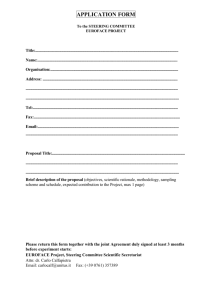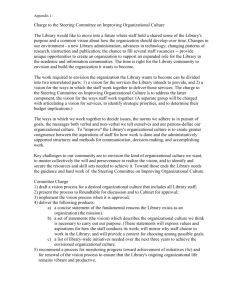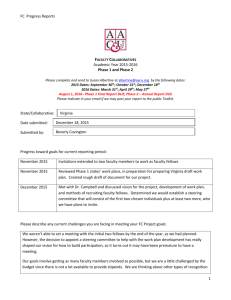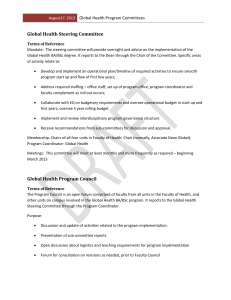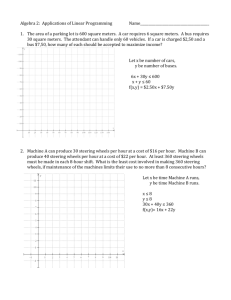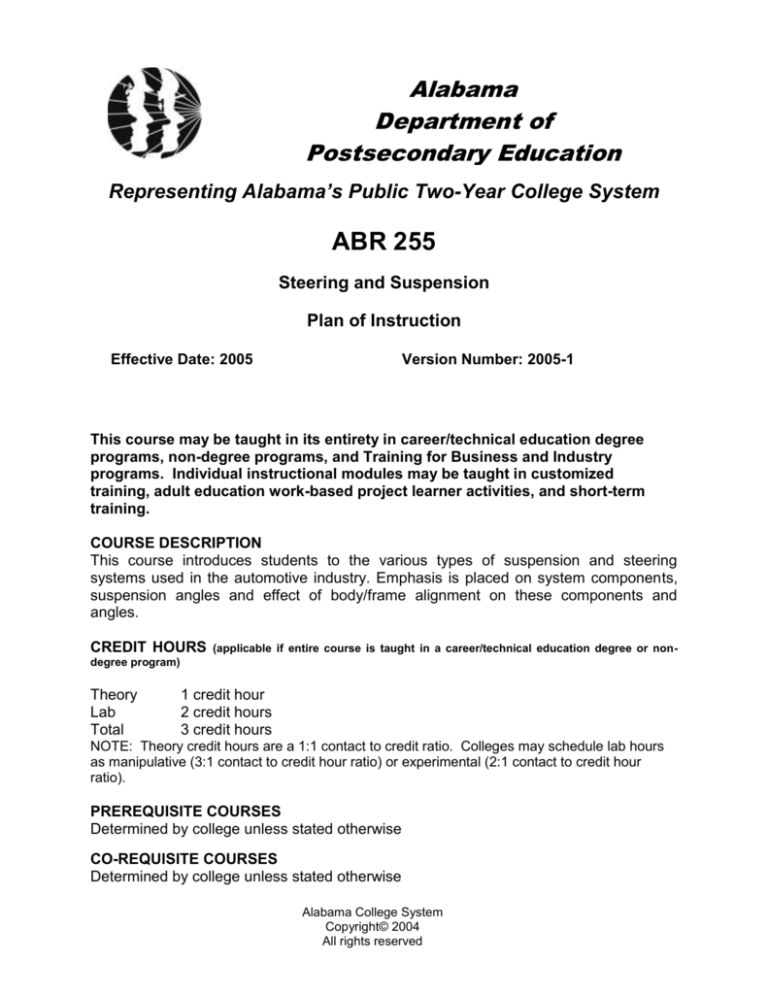
Alabama
Department of
Postsecondary Education
Representing Alabama’s Public Two-Year College System
ABR 255
Steering and Suspension
Plan of Instruction
Effective Date: 2005
Version Number: 2005-1
This course may be taught in its entirety in career/technical education degree
programs, non-degree programs, and Training for Business and Industry
programs. Individual instructional modules may be taught in customized
training, adult education work-based project learner activities, and short-term
training.
COURSE DESCRIPTION
This course introduces students to the various types of suspension and steering
systems used in the automotive industry. Emphasis is placed on system components,
suspension angles and effect of body/frame alignment on these components and
angles.
CREDIT HOURS
(applicable if entire course is taught in a career/technical education degree or non-
degree program)
Theory
Lab
Total
1 credit hour
2 credit hours
3 credit hours
NOTE: Theory credit hours are a 1:1 contact to credit ratio. Colleges may schedule lab hours
as manipulative (3:1 contact to credit hour ratio) or experimental (2:1 contact to credit hour
ratio).
PREREQUISITE COURSES
Determined by college unless stated otherwise
CO-REQUISITE COURSES
Determined by college unless stated otherwise
Alabama College System
Copyright© 2004
All rights reserved
Steering and Suspension
ABR 255
INSTRUCTIONAL NOTE: Foundational academic skills in Math such as integers,
percents, ratio and proportions, metric system and linear equations; and Technical
Writing such as research, organization, composition, documentation, and report
presentation are used throughout this discipline.
INDUSTRY/PROFESSIONAL COMPETENCIES
Correct damaged suspension system.
Correct damaged steering system.
GENERAL INSTRUCTIONAL OBJECTIVES
The cognitive objective of this course is for each student to comprehend foundational
knowledge of automotive steering and suspension.
The performance objective of this course is for each student to apply foundational
knowledge of automotive steering and suspension encountered in a classroom
simulated industrial environment.
Alabama College System
Copyright© 2004
All rights reserved
2
Steering and Suspension
ABR 255
INDUSTRY/PROFESSIONAL COMPETENCIES-STUDENT PERFORMANCE
Unless otherwise indicated, evaluation of student’s attainment of cognitive and
performance objectives is based on knowledge gained from this course. During
performance evaluations, students will be provided necessary tools, equipment,
materials, specifications, and any other resources necessary to accomplish the task.
Specifications may be in the form of, but not limited to, manufacturer’s specifications,
technical orders, regulations, national and state codes, certification agencies, locally
developed lab assignments, or any combination of specifications.
MODULE A – SUSPENSION SYSTEMS
INDUSTRY/PROFESSIONAL
STUDENT PERFORMANCE OBJECTIVES
COMPETENCIES
A1.1 Inspect, remove, and replace McPherson strut
A1.0 Repair damaged suspension
components.
system. (2b)
A1.2 Inspect, remove, and replace control arms and
components.
A1.3 Inspect, remove, and replace rear shock
absorbers and components.
A1.4 Inspect and align engine cradle.
A1.5 Inspect, remove, and replace rear suspension,
axle, and components.
A1.6 Inspect and adjust caster and camber.
A1.7 Adjust or repair rear toe, thrust angle, and wheel
setback.
A1.8 Diagnose needed wheel and tire repairs.
A1.9 Diagnose run out and balance tires.
ENABLING OBJECTIVES
A1.1.1 Identify inspection criteria for McPherson strut components.
A1.1.2 Explain the inspection, removal and replacement of McPherson strut
components
A1.2.1 Identify inspection criteria for control arms and components.
A1.2.2 Explain the inspection, removal and replacement of control arms and
components.
Alabama College System
Copyright© 2004
All rights reserved
KSA
Indicator
a
c
a
c
3
Steering and Suspension
ABR 255
A1.3.1 Identify inspection criteria for rear shock absorbers and components.
A1.3.2 Explain the inspection, removal and replacement of rear shock absorbers
and components.
A1.4.1 Identify inspection criteria for engine cradle.
A1.4.2 Explain the inspection and alignment of engine cradles.
A1.5.1 Identify inspection criteria for rear suspension, axle, and components.
A1.5.2 Explain the inspection, removal and replacement of rear suspension, axle,
and components.
A1.6.1 Identify inspection criteria for caster and camber.
A1.6.2 Explain the inspection and adjustment of caster and camber.
A1.7.1 Identify adjustment settings for rear toe, thrust angle, and wheel set back.
A1.7.2 Explain adjustment and repair for rear toe, thrust angle, and wheel set back.
A1.8.1 Determine wheel and tire repair requirements.
A1.9.1 Determine run out and tire balance requirements.
a
c
a
c
a
c
c
a
a
c
c
c
MODULE B – STEERING SYSTEMS
INDUSTRY/PROFESSIONAL
COMPETENCIES
B1.0 Repair damaged steering
system.
(2b)
STUDENT PERFORMANCE OBJECTIVES
B1.1 Inspect and replace steering pump.
B1.2 Inspect and replace parallelogram steering system
components.
B1.3 Inspect, remove, and replace steering knuckle and
coil spring.
B1.4 Diagnose and repair steering system malfunctions.
B1.5 Inspect and diagnose steering axis inclination and
king pin inclination.
KSA
ENABLING OBJECTIVES
Indicator
B1.1.1 Identify inspection criteria for steering pumps.
B1.1.2 Explain the inspection and replacement of steering pumps.
B1.2.1 Identify inspection criteria for parallelogram steering system components.
B1.2.2 Explain the inspection and replacement of parallelogram steering system
components.
B1.3.1 Identify inspection criteria for steering knuckle and coil spring.
B1.3.2 Explain the inspection, removal, and replacement of steering knuckles and
coil springs.
B1.4.1 Identify steering system malfunctions.
B1.4.2 Determine steering system repair requirements.
B1.4.3 Explain the repair process for steering system malfunctions.
B1.5.1 Identify inspection criteria for steering axis inclination and king pin inclination.
B1.5.2 Determine steering axis inclination and king pin inclination requirements.
B1.5.2 Explain the inspection and diagnoses of steering axis inclination and king pin
inclination.
Alabama College System
Copyright© 2004
All rights reserved
a
c
a
c
a
c
a
c
c
a
c
c
4
Steering and Suspension
ABR 255
COURSE CONTENT OUTLINE
MODULE A – Suspension Systems
Struts
Control Arms
Rear Shocks
Engine Cradle
Rear Suspension and Axle
Caster and Camber
Toe, Thrust angle, and Wheel Set Back
Wheels and Tires
MODULE B – Steering Systems
Steering Pumps
Parallelogram Steering System Components
Steering Knuckle and Coil Spring
Malfunctions
Axis Inclination and King Pin Inclination
Alabama College System
Copyright© 2004
All rights reserved
5
Steering and Suspension
ABR 255
RECOMMENDED METHODS OF EVALUATION: The tables of specifications below
identify the number of cognitive (knowledge) enabling objectives and psychomotor
(performance) objectives per module. Instructors should develop sufficient
numbers of evaluation items to ensure complete coverage of each cognitive
and/or psychomotor objective as identified in each module. For cognitive
objectives, use appropriate written test items based on the complexity indicator for each
objective. For psychomotor objectives, create comprehensive checklist evaluations.
Facts/Nomenclature (A/a): Multiple Choice, Fill-in, List, Matching, Alternative
Response (true/false or yes/no)
Principles/Procedures (B/b): Multiple Choice, Fill-in, List, Short Answer
Analysis/Operating Principles (C/c): Multiple Choice, Short Answer, Essay
Evaluation/Complete Theory (D/d): Multiple Choice, Short Answer, Essay
ENABLING OBJECTIVES TABLE OF SPECIFICATIONS
Cognitive Domain
Module A
Module B
Total
Facts/
Nomenclature
Principles/
Procedures
7
5
12
0
Analysis/
Operating
Principles
9
7
16
Evaluation/
Complete
Theory
0
Total
16
12
28
STUDENT PERFORMANCE OBJECTIVES TABLE OF SPECIFICATIONS
Psychomotor Domain
Module A
Module B
Total
Limited
Proficiency
(Level 1)
0
Partially
Proficient
(Level 2)
0
Proficient
(Level 3)
9
5
14
Alabama College System
Copyright© 2004
All rights reserved
Highly
Proficient
(Level 4)
0
Total
9
5
14
6
Steering and Suspension
ABR 255
Knowledge, Skills, and Abilities (KSA) Indicators
Performance
Ability
Value
4
Key Word(s)
Highly
Proficient
3
Proficient
2
Knowledge
Knowledge of Skills
1
d
c
Partially
Proficient
Limited
Proficiency
Complete
Theory
Operating
Principles
b
Procedures
a
Nomenclature
D
Evaluation
C
Analysis
B
Principles
A
Facts
Definition
Can do the complete competency quickly and accurately. Can tell or
show others how to do the competency.
Can do all parts of the competency. Needs only a spot check of
completed work
Can do most parts of the competency. Needs help only on hardest
parts.
Can do simple parts of the competency. Needs to be told or shown
how to do most of the competency.
Can predict, isolate, and resolve problems about the competency
Can identify why and when the competency must be done and why
each step is needed.
Can determine step-by-step procedures for doing the competency.
Can name parts, tools, and simple facts about the competency.
Can evaluate conditions and make proper decisions about the
subject.
Can analyze facts and principles and draw conclusions about the
subject.
Can identify relationship of basic facts and state general principles
about the subject.
Can identify basic facts and terms about the subject
Alpha Scale Values - Any item with an upper case letter (A, B, C, D) by itself is taught as general information on a
topic. This information may be related to the competency or encompass multiple competencies. Examples might
include mathematical computations or knowledge of principles such as Ohm’s Law.
A lower case letter indicates a level of “Knowledge of Skills.” Individuals are taught information pertaining to performing
a competency. These may be indicated alone or in conjunction with a numerical scale value. A lower case letter by
itself indicates the individual is not required to perform the task-just know about the task. (Example: Can state or
explain procedures for doing a task).
Numerical Scale Values - The numbers reflect the levels the individual will be able to perform a competency. Number
values are always accompanied by lower case letters (i.e. 1a, 2b, 3c...etc.) in order to specify the level of knowledge of
skills associated with the competency.
Example: An individual with a competency with a scale indicator of 3b has received training of knowledge of skills
whereby he or she can determine the correct procedures and perform with limited supervision; only requiring evaluation
of the finished product or procedure.
NOTE: Codes indicate terminal values.
Alabama College System
Copyright© 2004
All rights reserved
7
Steering and Suspension
ABR 255
RECOMMENDED INSTRUCTIONAL METHODOLOGIES: The table below links the teaching
methods and activities most effective for facilitating student achievement of learning outcomes
published in this plan of instruction.
Cognitive Level
Goal For Students
Teaching Methods
Teaching Activities
(Thinking)
Knowledge
Descriptive Verbs:
Defines, Lists, States,
Describes, Identifies
Comprehension
Descriptive Verbs:
Describe, Explains,
Summarizes
Knows common terms,
specific facts, methods,
procedures, basic
concepts, principles
Understands facts and
principles
Interprets verbal material
Interprets charts and
graphs
Lecture
Computer-based
Instruction
Video
Demonstration
Informal Lecture
Discussion
Demonstration
Participation
Interactive Computer
Based Instruction
Translates verbal material
to mathematical formulas
Estimates future
consequences
Mnemonics
Examples or Illustrations
Repetition
Summaries
Reviews
1. Teach to the Knowledge Level
2. Explains and demonstrates
concept, principle or procedure
learned
3. Put students in new
situation, and instructor and
students co-solve employing
the indicated concept, principle,
or procedure.
4. Put students in a new situation,
and the students solve the new
situation using the concept,
principle, or procedure while
instructor supervises.
Justifies methods and
procedures
5. Remediate/Reteach as required
Application
Descriptive Verbs:
Uses, Solves, Operates,
Produces,
Demonstrates, Constructs
Applies concepts and
principles to new situations
Applies laws and theories
to practical situations
Solves mathematical
problems
Demonstration
Individual Research
Lab Exercises
Case Studies
Experiments
Clinicals
Demonstrates correct
usage of a method or
procedure
Mechanism
Descriptive Verbs:
Assembles, calibrates, inserts,
removes, constructs,
measures, fixes, dismantles,
sketches
Goal For Students
Learned responses have
become habitual and can
be performed with some
confidence and proficiency
as designated by the KSAs
2. Teach to the Comprehension
Level
3. Student must identify the
concept, principle, or procedure
and use it to solve new
scenario(s)
Constructs charts, graphs,
or simple mechanisms
Psychomotor Level
(Doing)
1. Teach to the Knowledge Level
4. Remediate/Reteach as required
Teaching Methods
Lab Exercises
Case Studies
Experiments
Alabama College System
Copyright© 2004
All rights reserved
Teaching Activities
1. Demonstration
2. Observation
3. Evaluation
4. Feedback
5. Remediate/Reteach as required
8
Steering and Suspension
ABR 255
Glossary of Terms
Plan of Instruction (POI)
A teaching-learning plan which includes student centered instructional objectives,
outlined content, instructional and evaluation strategies, and other relevant
information needed to guide the development and/or revision of learning
experiences such that students achieve stated educational and performance
outcomes.
Industry/Professional
Competencies
A major task that individuals perform in a given industry or profession. From
these major tasks, performance objectives can be developed. Meeting
performance objectives indicates a student has attained the associated
industry/professional competencies. Taken together, these support the Course
Instructional Objectives.
Course Instructional
Objectives
The overall goal of the course of instruction stated in broad terms. This is
supported by the attainment/completion of the competencies and associated
competency tasks and sub-tasks.
Task
A skill that individuals perform that enables them to accomplish and satisfactorily
complete/attain as given competency.
Student Performance
Objectives
The skills each student is required to demonstrate during or at the conclusion of
each module or course. These skills are the direct result of the
attainment/completion of the professional competencies.
Enabling Objectives/Key
Indicators
The required knowledge and/or skill each student must acquire in order to have the
best chance of achieving the stated Student Performance Objective.
Knowledge, Skills, and
Abilities (KSA) Indicator
A table that provides an alpha/numeric indicator of knowledge, knowledge of skills,
and performance ability(s) students must demonstrate at the conclusion of
specified instruction. Each competency designates the terminal level of KSA
students must achieve. Enabling objectives/Key Indicators have a separate KSA
designating the level of knowledge students must have in order to perform the
associated competency(s).
Modules
A grouping of interrelated knowledge and skills representing a sub-task of a
course. Modules may be taught independently of other course content.
Prerequisite Courses
Courses students are required to successfully complete before being allowed
entrance into other courses
Instructional Note
Knowledge and skills relevant to the course that students will be demonstrating
during the course. For example: computer, technical writing, mathematics, and
speaking skills.
Alabama College System
Copyright© 2004
All rights reserved
9
Steering and Suspension
Course Prefix/numbers
Co-requisite Course
Modules
Course Content Outline
Contact/Credit hours
Prerequisite Knowledge
Recommended Methods of
Evaluation
Recommended Instructional
Methodologies
Course Prefix/numbers
Co-requisite Course
Modules
Course Content Outline
Contact/Credit hours
Prerequisite Knowledge
Recommended Methods of
Evaluation
Recommended Instructional
Methodologies
ABR 255
GLOSSARY OF TERMS (Cont)
Used to identify courses taught in multiple disciplines.
Course required in conjunction to the specified course often in the form of a lab
A grouping of interrelated knowledge and skills representing a sub-element of a
course.
A listing of topics for instruction in a particular course
Specifies the recommended contact to credit hours for each course. Mandates the
total credit hours awarded for each course.
Intellectual capabilities required for handling the academic rigors of the discipline.
Suggests test item options for measuring student achievement of enabling
objectives. Suggests the number of test items required to adequately measure
student achievement of enabling objectives. Mandates the evaluation of criterion
objectives.
Suggests the most effective instructional methods for achieving stated learning
levels
Used to identify courses taught in multiple disciplines.
Course required in conjunction to the specified course often in the form of a lab
A grouping of interrelated knowledge and skills representing a sub-element of a
course.
A listing of topics for instruction in a particular course
Specifies the recommended contact to credit hours for each course. Mandates the
total credit hours awarded for each course.
Intellectual capabilities required for handling the academic rigors of the discipline.
Suggests test item options for measuring student achievement of enabling
objectives. Suggests the number of test items required to adequately measure
student achievement of enabling objectives. Mandates the evaluation of criterion
objectives.
Suggests the most effective instructional methods for achieving stated learning
levels
Directions for Use
1.
2.
3.
4.
5.
6.
7.
8.
9.
10.
11.
Review the entire document.
Review the competencies specified in the POI keeping in mind that the stated
skills are the target outcomes for the course.
Review the student performance objectives written for each competency keeping
in mind the objective specifies the behavior each student must exhibit in order to
achieve the competency.
Adjust evaluation instruments to ensure each objective is addressed.
Develop additional evaluations as needed.
Review enabling objectives/key indicators specifying student outcomes
Adjust evaluations to ensure adequate sampling of student learning outcomes.
Evaluate current classroom curriculum and determine if learning experiences
support student achievement of skills identified in objectives.
Review recommended instructional methodologies for teaching activities.
Develop appropriate learning experiences.
Adjust course syllabus.
Alabama College System
Copyright© 2004
All rights reserved
10


